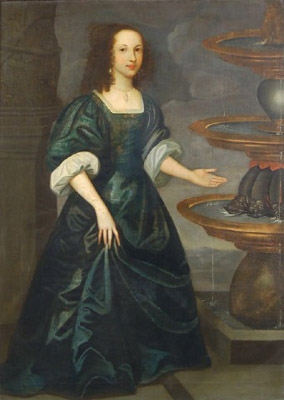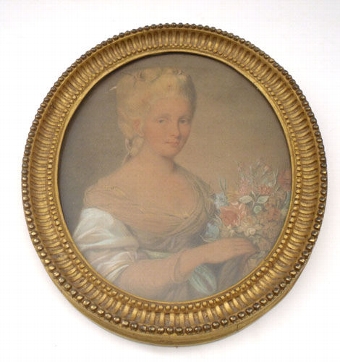Frame 61"H x 46"W.
Frame 61"H x 46"W. Henrietta Maria (25 November 1609 ? 10 September 1669), was Princess of France and Queen Consort of England, Scotland and Ireland (13 June 1625 ? 30 January 1649) through her marriage to Charles I. She was the mother of two kings, Charles II and James II, and was grandmother to both William and Mary and Queen Anne. Born as Henriette-Marie de France, Princess of France, she was the youngest daughter of Henry IV of France and Maria de Medici and the sister of the future Louis XIII of France and had 7 other siblings. Her father was killed before she was a year old; her mother was banished from the royal court in 1617. She was born at the Louvre Palace and brought up as a Roman Catholic. This made her an unpopular choice of wife for the English King, whom she married by proxy on 11 May 1625, shortly after his accession to the throne. They were married in person at St. Augustine''s Church, Canterbury, Kent, on 13 June 1625. However, her religion made it impossible for her to be crowned with her husband in an Anglican service. Initially their relationship was cold. Henrietta Maria had brought many servants with her from France, all of them Roman Catholic, and all costing the King a lot of money to maintain. It is said that eventually Charles sent this retinue home, only allowing his teenage bride to retain her chaplain and two ladies in waiting. Finding her sadly watching the retinue depart for France at the window of a palace, Charles angrily and forcibly dragged his wayward queen away. Charles had intended to marry Maria Anna, a daughter of Philip III of Spain, but a mission to Spain in 1623 had failed. Perhaps this earlier disappointment explains why relations with his French bride were strained; every time the couple met, they started arguing and would separate, not seeing each other for weeks. When next they met, again they had to separate, because they could not stop arguing. Henrietta Maria took an immediate dislike to George Villiers, 1st Duke of Buckingham, the King''s favourite. However, after Buckingham was murdered by John Felton in August 1628, her relationship with the King improved and they finally forged deep bonds of love and affection. Her refusal to give up her Catholic faith alienated her from many of the people and certain powerful courtiers such as William Laud, Archbishop of Canterbury and Thomas Wentworth, Earl of Strafford. Charles, on the other hand, had definite leanings towards Catholicism, and, once he had reached maturity, did not share his father''s sexual ambivalence. Henrietta Maria increasingly took part in national affairs as the country moved towards open conflict through the 1630s. She despised Puritan courtiers to deflect a diplomatic approach to Spain and sought a coup to pre-empt the Parliamentarians. As war approached she was active in seeking funds and support for her husband, but her concentration on Catholic sources like Pope Urban VIII and the French angered many in England and hindered Charles'' efforts. She was also sympathetic to her fellow Catholics and even gave a requiem in her private chapel at Somerset House for Father Richard Blount, S.J. upon his death in 1638. In August 1642, when the conflict began, she was in Europe. She continued to raise money for the Royalist cause, and did not return to England until early 1643. She landed at Bridlington in Yorkshire with troops and arms, and joined the Royalist forces in northern England, making her headquarters at York. She remained with the army in the north for some months before rejoining the King at Oxford. The collapse of the king''s position following Scottish intervention on the side of Parliament, and his refusal to accept stringent terms for a settlement led her to flee to France with her sons in July 1644. Charles was executed in 1649, leaving her almost destitute. She settled in Paris, appointing as her chancellor the eccentric Sir Kenelm Digby. She angered both Royalists in exile and her eldest son by attempting to convert her youngest son, Henry, to Catholicism. She returned to England following the Restoration in October 1660 and lived as ''Dowager Queen'' and ''Queen Mother'' at Somerset House in London until 1665 when she returned permanently to France. Her financial problems were resolved by a generous pension. She founded a covent at Chaillot, where she settled. Henrietta Maria died at Ch?teau de Colombes, and was buried in the royal tombs at Saint Denis Basilica near Paris. Edward Bower is believed to have come from Totnes area, and to have been a servant to Van Dyck, complaints were ledged against him by the painter stainer''s company 1629. Became the societies upper warden in 1656 and Master in 1661. Had a studio at Temple Bar, London by 1637. In Jan 1648/9 he made the variant portrait of Charles I at his trial, which was much copied.
Antiques.co.uk Ref: MEENUGAG
- Materials:
- Oil on Canvas
- Width (cm):
- 132.08cm x 93.98cm (52 x 37 ins)














